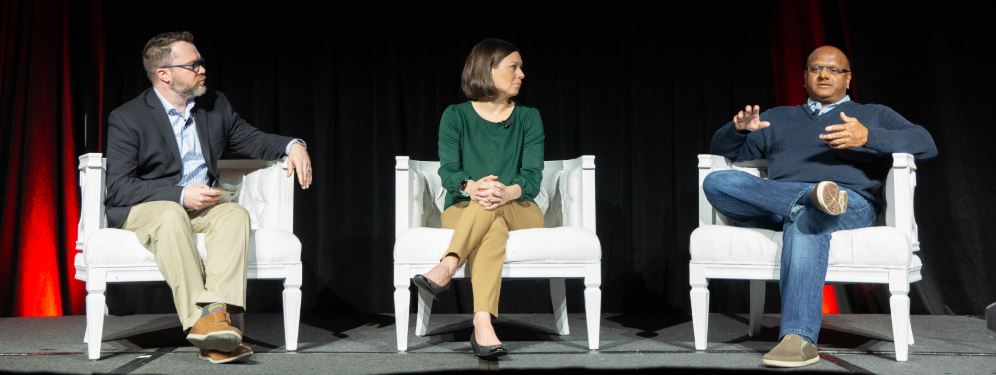At IFMA’s 2019 Chain Operators EXchange (COEX), a panel of blockchain experts shared their knowledge on the foodsevice industry’s blockchain status and provided insights into the future. These blockchain leaders from GS1 US, FoodLogiQ, and Ripe.io have since taken a deeper dive into some unanswered questions. We will be exploring these questions over a series of articles.

From left to right: Kevin Otto, Katy Jones, Raja Ramachandran
Data standards and data access are certainly keys to success. Beyond adopting GS1 standards, what steps can companies take to get their data ready for Blockchain? How do we make this concept accessible, what is the first step to begin working towards a Blockchain future?
Kevin Otto, Senior Director of Community Engagement, GS1 US:
In addition to adopting GS1 standards, it is important to have a clear strategy around data governance. Many industry stakeholders also have concerns around data storage and permissions on an enterprise blockchain ledger. A best practice seems to be emerging among early adopters. They store a small amount of reference data on enterprise ledgers, while ensuring that richer data can be stored and accessed through applications that reside “off-chain” in traditional data stores. A key first step for preparing your data for blockchain is to determine “which data” must reside on the ledger and which data can be accessed off-chain. Addressing this topic early in your implementation is essential to ensuring interoperability.
We believe that the companies that are likely to be successful with blockchain are those who actively collaborate with industry partners to gain consensus and alignment on these concepts early on. For example, GS1 US offers a blockchain discussion group, and programs on related topics such as data quality and supply chain visibility, which are essential to blockchain success. It is through this self-education and idea exchange that the best foundations for innovation are launched.
Any new innovation, whether it’s blockchain or AI or another technology, benefits from collaboration. The company can better anticipate challenges, learn strategies for scaling the technology, and take away key anecdotes and examples that you normally wouldn’t have access to if you were only speaking to people within your organization.
Katy Jones, Chief Marketing & Strategy Officer, FoodLogiQ:
Before any organization is ready to pursue and potentially scale blockchain, three key things have to happen. The underpinning of blockchain readiness is getting your data in a standardized format. This process includes:
- Item identification and standardization: It’s important that everyone in your supply chain is speaking the same language with regard to a product’s identification and location information so that data can be exchanged and understood. At FoodLogiQ, we accomplish this by using a Global Trade Identification Number (GTIN) to uniquely identify items, as well as a Global Location Number (GLN) to identify facilities. This is an industry best practice.
- Data submission: Everyone along your supply chain needs to be able to share critical tracking event data, and often technology is a challenge. Some users are more advanced than others. With a nimble system, data can be uploaded in different ways based on your company’s technical capabilities. (Using FoodLogiQ Connect, customers can upload in six different ways.)
- Analysis: True visibility into your company’s supply chain occurs when users are empowered to evaluate that data and make intelligent decisions based on analysis. (Through FoodLogiQ Connect’s Investigations function, you have the ability to set granular specifications to get the information you need.)
Raja Ramachandran, CEO, Ripe.io:
There are several key steps to prepare for a blockchain future. First, there has to be executive buy in on the vision that this new technology can either disrupt or enable existing businesses. That thesis should then drive examination by key business groups who represent business units. This is for enterprises. For smaller entities, they will have to compact those steps into one or two individuals who then have to seek out blockchain companies that can help them test the value proposition.
Second, defining key use and business cases are critical. And they have to be born not out of hearing about traceability because blockchains are only a part of that solution for ones that already exist. No, they have to seek out unbiased business problems and or future states they would like to achieve for data, transparency and a single record of truth and trust.
Trying to pack in traceability into the problem definition will be a backward way to look at things.
Third, follow a criterion set for rationalizing the use of blockchain. Is there a lack of trust in an important economic ecosystem? Is there a need for a single, trusted transaction and view? Will the ecosystem and independent consensus of the transaction be achievable with procedure harmonization above where it is today? And will the ecosystem collectively invest it in. Once these are in the affirmative, then you can move into the details of a use case and project.
The rest is about project management, data and technology, analysis and so on.
